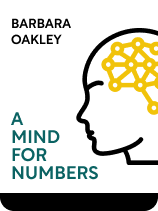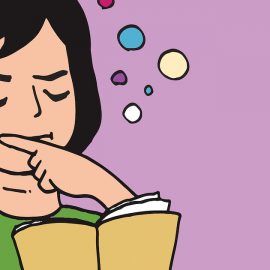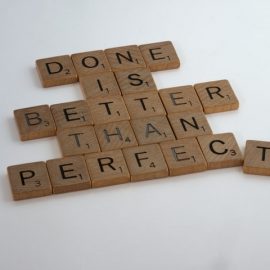

This article is an excerpt from the Shortform book guide to "A Mind for Numbers" by Barbara Oakley. Shortform has the world's best summaries and analyses of books you should be reading.
Like this article? Sign up for a free trial here .
Do you tend to put off studying until the last minute? Do you cram rather than measure your time?
In A Mind for Numbers, author Barbara Oakley addresses the problem of procrastination, particularly in the context of learning math and science. She explains why procrastination (including cramming) is a problem, outlines the four components of habitual procrastination, and shares seven strategies for overcoming procrastination.
Keep reading to learn how to stop procrastinating and start studying.
Stop Your Procrastinating
According to Oakley, habitual procrastination is often your most significant barrier to learning math and science. We’ll discuss Oakley’s model of the procrastination habit and her recommended strategies for avoiding procrastination, and we’ll compare them to others’ recommendations.
Why Is Procrastination a Problem?
Oakley acknowledges that procrastination, in the strictest sense, is not always a problem: Sometimes you can make better use of your time by deferring certain tasks until later. Rushing into a task with unfounded assumptions may necessitate rework, while pausing to reflect gives you a chance to apply lessons from previous tasks to new projects.
However, Oakley also asserts that habitual procrastination is a problem because you need to make conscious decisions about how to spend your time in order to spend it productively. She cautions that, like any habit, you can slip into procrastination without thinking, or even without realizing you are doing it. If you’re like many people, you need to learn how to stop procrastinating and start studying.
| A Corroborating Perspective on Creative and Destructive Procrastination In Eat That Frog, Brian Tracy argues that there will always be more things you could do than you have time for. Thus, according to Tracy, the key to success is to continually identify what’s most important for you to work on at the moment, and work on it. That means putting off everything else. He calls this practice of putting off less-important tasks “creative procrastination.” However, since it takes conscious thought to identify your most important task, Tracy would probably agree with Oakley that habitual procrastination is problematic. Moreover, although he advocates “creative procrastination,” he also says that overcoming procrastination on your most important tasks is one of the keys to success. Although Tracy doesn’t identify procrastination as a habit, Tracy does prescribe “success habits” as the antidote to procrastination. He says that completing difficult, important tasks gives you a sense of satisfaction that can be addictive: You can use this as the reward to cultivate a habit of tackling your most important tasks first. |
Don’t Try to Cram
According to Oakley, you cannot learn math and science by cramming at the last minute. She explains that when procrastination encroaches on your study time, you’re left with only enough time for superficial focused-mode thinking. But the diffuse-mode thinking that happens between deeply focused study sessions is what establishes the neural patterns in your brain, and so superficial focused-mode studying is not very effective. You would do well to learn how to stop procrastinating and start studying.
(Shortform note: Scientific studies corroborate these assertions. One study established that procrastination on academic assignments results in poorer performance for accounting students, and another experiment found similar results for students assigned to write essays. A separate neurological study observed elevated activity in the brain’s “default mode network” when subjects performed activities requiring introspective thought. Since the brain’s “default mode network” is associated with diffuse-mode thinking, this implies that the diffuse mode is involved in storing and retrieving ideas, just as Oakley says.)
Anatomy of the Procrastination Habit
Oakley explains that habitual procrastination has the same four components as other habits:
1. The Cue: According to Oakley, the procrastination cue comes in two parts. The first part is the “pain of anticipation,” the unpleasant feeling you get from anticipating an activity makes you uncomfortable.
(Shortform note: Oakley references a neurological study where researchers monitored the brain activity of “HMAs,” that is, people who suffer high math anxiety. The study found that when these people thought about working on math problems, their brains showed increased activity in regions associated with identifying danger and experiencing pain. However, these regions did not show elevated activity when the HMAs were actually working on math problems. This establishes that “pain of anticipation” is a real, physical sensation. It also implies that, at least in the case of math, the pain of anticipation is much worse than the discomfort of actually doing the math.)
Oakley notes that the second part of the procrastination cue is the “distraction,” which is any stimulus that you can shift your focus to in order to escape the pain of anticipation. For example, the distraction could be receiving an email, or catching a whiff of your roommate’s lunch.
2. The Routine: Oakley explains that the procrastination chunk in your brain generally doesn’t have just one routine, but rather several sub-routines. The type of distraction that completes the cue determines which sub-routine gets triggered. For example, if the distraction is a new email from an online retailer, maybe the sub-routine consists of following the link in the email and mindlessly browsing the retailer’s website.
3. The Reward: According to Oakley, the reward that allows a procrastination habit to develop is temporary relief from the pain of anticipation.
4. The Belief: Oakley reiterates that one of the keys to changing any habit is believing that you can change. If you’ve been procrastinating habitually for a long time, it might be tempting to believe procrastination is an innate part of who you are, but understanding the makeup of the procrastination habit can help you change this belief.
| Comparison of Procrastination Models Procrastination was first identified as a habit in the early 1900s. Before that, it was widely regarded as a form of laziness. Treating procrastination as a habit, Clear and Duhigg would probably model it similarly to Oakley. Meanwhile in Fogg’s model: The distraction would serve as the prompt. The behavior would be the sub-routine for that particular distraction. Ability would be high because the actions involved in procrastination sub-routines are so easy to perform. The pain of anticipation would provide motivation. Since ability and motivation both tend to be high in the case of procrastination, Fogg’s model seems to predict that you would almost always perform the behavior when presented with the prompt. This could help to explain procrastination habits are so pervasive. However, not all researchers agree that procrastination should be modeled as a habit. One study found that procrastination correlated more strongly with conditions like depression and low-self esteem than with aversion to the task, that is, with the pain of anticipation. From this, the researchers concluded that procrastination often stems from cognitive-behavioral issues, and not just from deficient study habits. Furthermore, according to Dan Ariely, procrastination is the result of irrational decisions that we make when emotionally aroused. He asserts that we all naturally alternate between two states of mind: One is the “cool state” where we make rational plans and decisions. The other is an “aroused state” brought on by emotional stimuli such as anger, fear, or desire, in which we often make irrational decisions and tend to set aside our rational goals in favor of instant gratification. Procrastination vs Distraction Meanwhile, other authors address equivalent behaviors using different words. For example, in Indistractable, Nir Eyal defines “distraction” as any behavior that draws you away from the tasks that you need to focus on to accomplish your goals. He asserts that we are all fundamentally motivated to free ourselves from discomfort, and we get distracted because distractions offer temporary relief from mental discomfort. Furthermore, Eyal states that distractions start with “triggers” and distinguishes between internal and external triggers. He equates internal triggers to the sense of discomfort or dissatisfaction that prompts you to look for an escape. External triggers, then, are environmental stimuli that interrupt your concentration and/or offer an opportunity for escape. Thus, “distraction” as used by Eyal seems to be functionally synonymous with “procrastination” as used by Oakley, and Eyal’s description of the root cause of distraction is compatible with Oakley’s description of the procrastination habit model. Eyal’s internal and external triggers correlate closely to the two parts of the procrastination cue that Oakley identifies. |
Strategies for Overcoming Procrastination
Oakley offers seven ways to learn how to stop procrastinating and start studying.
Strategy 1: Plan Your Time
According to Oakley, planning your time is a powerful strategy for taking control of habits like procrastination. There are two benefits to having a plan:
First, Oakley says the act of planning out how to spend your time can reduce the temptation to procrastinate. She explains that having a written to-do list frees up your working memory, allowing you to focus on the task at hand, instead of having to mentally keep track of what you need to do next. She also says that breaking down distant deadlines into manageable tasks makes them less tempting to put off.
We infer that this works by reducing the pain of anticipation: If you rely on your to-do list instead of thinking about upcoming tasks, then you won’t think about them in advance enough for the anticipation to cause you discomfort. Furthermore, breaking down projects into manageable tasks makes them less daunting, and thus, less likely to cause pain of anticipation.
Second, Oakley notes that your plan allows you to track how you spend your time so you can identify specific procrastination habits. If you catch yourself procrastinating and make a note of it, you may be able to pin down specific cues, routines, rewards, and beliefs that you can target with additional tactics.
(Shortform note: James Clear also recommends tracking your habits with a journal or calendar. Not only does tracking help you identify habits you may need to change, but, as Clear emphasizes, it also allows you to see your progress, which can become a source of encouragement to keep improving.)
How to Plan Your Time
How should you go about planning your time? Oakley recommends keeping a journal planner in which you identify your important deadlines, key tasks for each week, and specific tasks for each day, as well as your intended quitting time. She advises you to write out your tasks for each day the evening before, so your brain’s diffuse mode can process the list while you sleep, making it easier to comprehend and complete your tasks.
Then, use your planner to track what tasks you actually complete and what time you actually quit each day. Oakley notes that it is easy to overestimate how much you can get done in a day, especially when you first start keeping a planner. However, once you calibrate your expectations, working later than expected or leaving tasks unfinished can alert you to procrastination habits that you might not have been aware of.
Oakley also suggests that if you have trouble keeping track of a journal-type planner, try hanging a whiteboard conspicuously on your front door to keep track of your daily tasks. This is not as good for long-term tracking, but it’s better than nothing.
(Shortform note: If you’re already in the habit of carrying a smartphone, a scheduling app can provide all the functionality of a journal planner and then some, without the need to keep track of anything you don’t already carry. A smartphone can also provide automatic reminders to help cue your study habits, unlike a traditional journal. Most phones come with pre-installed time-management apps such as Google Calendar or Apple Calendar, but there are also third-party apps such as MyStudyLife that are designed for students.)
| Timeboxing According to Eyal, building the right schedule is one of the four key components of overcoming distraction. He emphasizes that your schedule needs to accurately reflect your values: If you build a schedule that doesn’t support what you really care about, you’re only setting yourself up for getting distracted. This connects planning your time with the belief component of Oakley’s habit model: As we noted in Part 5, according to Oakley, to change a habit, you must believe that the change will be an improvement. The more the change helps to align your schedule with what you value, the more you will see it as an improvement. Eyal also asserts that just making a to-do list of daily tasks is not effective for overcoming distraction. He argues that it’s too easy to move uncompleted tasks to tomorrow’s list, allowing you to slip into distracting activities. To remedy this problem, he advocates a strategy called “timeboxing.” Timeboxing consists of splitting up your entire day into blocks (or boxes) of time, all of which are allocated to specific activities. This implies that you schedule not only your academic assignments and work-related tasks, but also your meals, sleep, housework, recreation, and blocks of time for administrative tasks like checking and responding to email. This way, if you find yourself doing anything other than what you planned to be doing at that time of the day or night, you can identify exactly when you were distracted. Eyal recommends scheduling one 20-minute time block each week to reflect on the times you got distracted and consider how you could adjust your schedule to avoid such distractions in the future. Thus, Eyal’s practice of timeboxing has the potential to amplify the benefits of scheduling your daily tasks and specifying your quitting time as Oakley suggested. Furthermore, Eyal argues that timeboxing creates a psychological “implementation intention” that makes you more likely to work on your planned tasks, and less likely to procrastinate or get distracted. (Psychologists define “implementation intentions” as plans of the form “If/When X happens, then I will do Y,” and contrast them with “goal intentions,” which take the form, “I want to achieve Z.” Studies affirm that you are more likely to achieve implementation intentions than goal intentions.) |
Strategy 2: Avoid Getting Burnt Out
Oakley warns that, as you tire out, the anticipation of more work becomes more painful. This amplifies the first part of the procrastination cue. Thus, to guard against procrastination, she advises tackling your most difficult tasks first each day, while you’re still fresh, and scheduling time for rest and recreation in addition to your work or studies.
She also notes that for this to work, you need a schedule that you can trust: If you add a couple of hours of relaxation to a schedule that is already optimistic, it will only put you further behind. Or, if you don’t know whether your schedule is achievable or not, then you may not be able to relax because you’re worried about finishing your tasks.
| Avoiding Burnout With Timeboxing and Positive Associations If you take Eyal’s approach to planning your time, this strategy gets built into the previous one automatically: Since you schedule everything, you naturally include blocks of time for rest and relaxation. Whether we treat this as another strategy for avoiding procrastination, or a sub-strategy of planning your time, the essence of this approach is to prevent fatigue from amplifying the pain of anticipation. But what if you could eliminate the pain altogether, or even turn it into pleasure? Ariely proposes an anti-procrastination strategy that amounts to exactly that. By creating positive associations between tasks that you tend to put off and pleasurable situations, you can sometimes overpower the pain of anticipation and turn the task as a whole into something you look forward to. For example, maybe you hate washing dishes, but you love listening to a certain genre of music. So, whenever you need to wash the dishes, you turn on your sound system and crank up the music. And you only let yourself listen to your music while you’re washing dishes. Pretty soon, you may find yourself throwing dinner parties just so you have more dishes to wash, but more importantly, the positive association makes the overall task pleasurable, eliminating the pain of anticipation. |
Strategy 3: Reframe Negative Thoughts
As another antidote for the pain of anticipation, Oakley recommends reframing any negative thoughts you have about your work so you can view it in a more positive light.
For example, suppose you’re overdue for a dental checkup, but you’ve been putting it off because going to the dentist is unpleasant. Try reminding yourself that regular dental visits can prevent tooth decay, and tooth decay can cause a lot more pain than a dental visit does. By keeping up on your dental plan, you’d be minimizing your suffering in the long run.
| Digging Deeper and Creating Play Eyal echoes Oakley’s recommendation to reframe negative perceptions of your work, and elaborates on it: He suggests that you can make tasks more interesting, meaningful, or even fun by digging deeper into them and/or playing games with them. Digging deeper could involve considering the purpose of the activity, as in our dental example, or it could involve going above and beyond the minimum requirements of the task. For example, maybe you’re dreading writing your lab report because writing that kind of documentation is dull, so you ask the question, “What would make this the ultimate lab report, instead of just a boring write-up?” Maybe you’re interested in art, and you realize that a few good sketches of the experiential set-up would make it a lot easier to explain. Or maybe you’re into computer programming, and you realize that you could write a python script to analyze the experiment data more precisely. In some sense, you might be making more work for yourself, but now writing your lab report becomes something you can be proud of, which makes it easier to work on. Playing games involves imposing limitations or constraints that create a sense of challenge to make the task more engaging. This could be as simple as setting a “par time” for each of your homework assignments and then trying to beat that time. Or it could be as challenging as organizing a study group where, for each of the assigned homework problems, two participants are selected at random, blindfolded, and given a blank sheet of paper. Then it’s a race to see who can solve the problem and write out the solution first, without being able to refer to their notes or even see what they’re writing. |
Strategy 4: Eliminate Distractions
Oakley points out that eliminating distractions eliminates cues, and thus keeps your procrastination habit from triggering. She also notes that different people are sensitive to different types of distractions. If you’re sensitive to auditory distractions, Oakley suggests using noise-canceling headphones to block them out. Hunger can also be a distraction, so she advises against tackling difficult tasks on an empty stomach.
Depending on your personality, Oakley suggests that your distraction-free zone might be an isolated study room in the library basement where there’s no cellphone reception, or it might be a table in a busy restaurant with music playing in the background.
| Types of Distractions and What to Do About Them According to Eyal, reducing “external triggers” is another one of the four keys to becoming indistractable. He breaks down external distraction triggers into categories and offers guidance on how to deal with them. First, he observes that most external triggers stem from one of two sources: people and technology. People-Based Distractions Eyal further sorts people-based distraction triggers into four categories: In-person interruptions. To minimize these, Eyal suggests a two-step process: First, communicate with the people you normally interact with so they understand your time-management system and know when you are and are not available. Then, create an obvious visual indicator that you are not available for interruption, such as a “Do Not Disturb” sign that you hang on your door or the back of your chair. Email communications. Eyal recommends establishing blocks of time in your daily schedule to check your inbox and respond to emails in batches, rather than reacting to every email when it arrives. Chatrooms. Eyal discusses mostly group-chat apps used in the workplace, but this category could include almost any real-time text-based messaging service, such as text messages on your phone. Again, he proposes to limit the scope of this distraction with timeboxing. Because the real-time aspect of chat is what sets it apart from email, he suggests getting the people you want to have group chat-room discussions with to agree mutually on a timebox for chat or text meetings, if possible. He notes that limiting the number of people that you correspond with on these platforms also helps to mitigate their potential for distraction. Meetings. In the workplace, meetings can be useful for problem solving, but they can also become counterproductive as a cause of distraction. The same can be said of academic study groups. Technology-Based Distractions Eyal likewise sorts technology-based distraction triggers into four categories: Your smartphone. Depending on what apps you have and what notifications or disturbances they generate, your phone can be a powerful tool for helping you stay on track or for distracting you. Eyal emphasizes the importance of considering each feature and function to see whether it supports or sabotages your schedule and values. He suggests deleting apps you don’t need and disabling most auto-notifications. Desktop clutter. According to Eyal, when you’re trying to work on something, seeing files for unfinished assignments, or other things that demand your attention in the background, acts as a constant distraction trigger. Resisting this trigger can drain your cognitive ability. Thus, he recommends organizing all your files and projects into folders that are out-of-sight when you’re not working on them. He discusses this mostly in regards to your computer desktop, but the same principle could apply to your physical desk as well. Articles. Eyal notes that there is a wealth of information available on the internet, but it is all too easy to be pulled from one article to the next and get distracted from what you need to get done. He recommends using an app or extension to archive select articles for reading later, without the distracting context of the web browser, rather than reading them when you find them or keeping them open where they can act as a distraction trigger. Social media. Eyal recommends installing apps or browser extensions that block newsfeed and algorithm-suggested content so that you can view the content you want to on social media, without getting distracted by other content. |
Strategy 5: Focus on the Process
According to Oakley, the pain of anticipating a distasteful assignment is more strongly connected with the “product,” that is, the assignment you need to complete, than it is with the “process” of working on the assignment. She says you can circumvent the first part of the procrastination cue by focusing on the work itself rather than the necessity of getting it done.
Further, Oakley notes that shifting your focus from product to process can help to address the belief component of a procrastination habit. For example, suppose you have a lab report due in one week. You may be able to rationalize putting it off until the evening before it’s due by assuming you can get it done in one evening. However, if you allocate two hours a day for working on your lab report, then it’s obvious that you can’t compress 14 hours of work into one evening.
| Corroborating Perspectives on Process Versus Product It appears that little if any of the neurological research on the pain of anticipation differentiates between process and product. Oakley may be basing her assertion that the pain of anticipation is associated more with the product than the process more on personal experience than formal research. However, she is not the only author to make this assertion or to advocate focusing on process over product. Francesco Cirillo states that “becoming” (as in the need to achieve or become something, especially by a certain deadline) is a significant source of anxiety for students and others, while the “succession of events,” or process that would get us there is not a significant source of anxiety. James Clear also advocates focusing on processes rather than goals, and his discussion suggests a psychological mechanism to explain why the pain of anticipation is more closely linked to goals than processes. Specifically, goals can delay the sense of gratification that motivates us to achieve them, and this can erode our motivation. Goals don’t provide any gratification until you achieve them, while processes can provide a sense of fulfillment just from working on them. For example, suppose you have a lab report to write. Finishing the report is your goal. Writing it is the process. Suppose you spend an hour each day working on writing your lab report. After four days, you’ve spent a total of four hours working on it, but you’re still not finished. If you’re focusing on the goal, you might be getting discouraged, because you’ve spent so much time on it, and you still haven’t achieved your goal. However, if you’re focused on the process, then you can take pride in the fact that you dedicated an hour each day to writing your lab report. And if you continue to focus on the process of writing your lab report, eventually you’ll finish it. As such, we infer that your brain tends to associate goals that took a long time to achieve with a sense of frustration, while processes that took the same amount of time to complete would not have that association. This would explain why it’s more painful to anticipate new, similar goals than their associated processes. |
The Pomodoro Technique
Oakley advocates using the “Pomodoro technique” because it naturally shifts your focus from the product (finishing your assignment) to the process (working on the assignment). The Pomodoro technique consists of setting a timer for 25 minutes and giving the task in question your undivided attention until the timer goes off. When the timer goes off, you take a break, and then repeat as needed. Oakley says you can vary the length of your breaks from five minutes to half an hour or more, depending on how urgently you need to finish your work.
According to Oakley, the Pomodoro technique is effective for building good study habits because the breaks allow you to reward yourself, and the length of time is attainable. You can focus for 25 minutes.
| Origins of the Pomodoro Technique Francesco Cirillo developed the Pomodoro technique while he was a university student in Italy. He went through a period where he felt confused and unproductive, and traced the cause to lack of focus. As he began to remedy the problem, he made a bet with himself that he could study for ten minutes without losing focus. He used a kitchen timer that was styled to look like a tomato, or “pomodoro” (Italian for “tomato”) to time himself for the bet. He found this exercise useful and refined it as he improved his study habits. Cirillo asserts that practicing the Pomodoro technique elevates your consciousness, clears your thoughts, and sharpens your focus. In his standard technique, a Pomodoro session consists of an indivisible, uninterruptible 25-minute work period, followed by a five-minute break, with a 30-minute break after four consecutive sessions. |
Strategy 6: Ignore Distractions
Ignoring a distraction amounts to overwriting the sub-routine associated with that cue. As such, it requires willpower, but Oakley says it is a key strategy for overcoming procrastination.
Oakley says the Pomodoro technique can be helpful for this, implying a connection between ignoring distractions and focusing on the process: If your focus is strong enough, distractions won’t be able to break it. However, there are other ways to ignore distractions. Oakley asserts that you can use meditation techniques to dismiss distracting thoughts.
| Using Mindfulness to Ignore Distractions Medical studies affirm that “mindfulness” meditation techniques tend to reduce susceptibility to distraction. What is mindfulness? In Mindfulness in Plain English, Gunaratana defines it as a state of mental awareness in which you listen to your thoughts without getting caught up in them. You assume a relaxed position, close your eyes, and just observe what’s going on in your mind, without expecting or reacting to anything, without pondering or analyzing anything, and without passing judgment on anything. Presumably, this practice has a decoupling effect on the cue element of procrastination: Every time you mentally observe a certain distraction without reacting to it, its connection to the sub-routine becomes weaker. |
Strategy 7: Leverage Others’ Motivation
To help circumvent procrastination, Oakley advises you to study where other people are studying. It is easier to do things that you see other people doing, so doing your homework in a study hall where other people are working on theirs makes it easier to get started.
| The Power of Precommitments If other people expect you to do something, their expectations can be even more motivating than just watching them do something similar. Eyal asserts that creating precommitments is one of the four keys to overcoming distraction or procrastination. One form of precommitment that Eyal describes is the “effort pact,” where you make a mutual commitment with someone else to do something together. For example, you might commit to meeting a classmate at the library, where you’ll both work on your homework for a set period of time. |

———End of Preview———
Like what you just read? Read the rest of the world's best book summary and analysis of Barbara Oakley's "A Mind for Numbers" at Shortform .
Here's what you'll find in our full A Mind for Numbers summary :
- How to make math and science intuitive
- Strategies for remembering complex concepts more easily
- How to build good study habits and avoid procrastination






